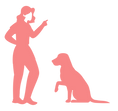A little about me and a lot about reactivity
- lstott0
- Sep 29
- 2 min read

Behavior has always fascinated me. What drives us to choose one action over another? Why do we form habits and stick to them even after they no longer serve us? There are several ways to answer these questions and, depending on your perspective, you may identify with one more than others.
I love the science of behavior and the challenge of learning the language of dogs. Each dog, like us, is an individual with unique abilities to interpret their environment, decide on best interaction, and integrate this with past experience and desired outcomes.
When face with a threat, they might act before thinking. The more imminent the threat, the quicker and less thought-out the response. Here's why this matters. A good trainer can help you identify the triggers - things, places, and people -that cause your dog to react. The trainer might suggest increasing the distance between your dog and the trigger. More distance means more time to assess the threat, helping you and your dog avoid an unpleasant reaction.
Reactivity is its own reward and can become a habit if repeated often enough. Once this behavior is a habit, reactivity is no longer a choice. Breaking a habit requires avoiding the behavior until it is no longer automatic. This process may go more quickly if you train a replacement behavior like a quick u-turn when a trigger appears. Or you may choose to desensitize and counter condition your dog to the triggers.
This process can be the beginning of new coping strategies and the development of resilience for your dog. A trainer can design an individualized plan to maximize results and help you and your dog relax and enjoy life.


Comments